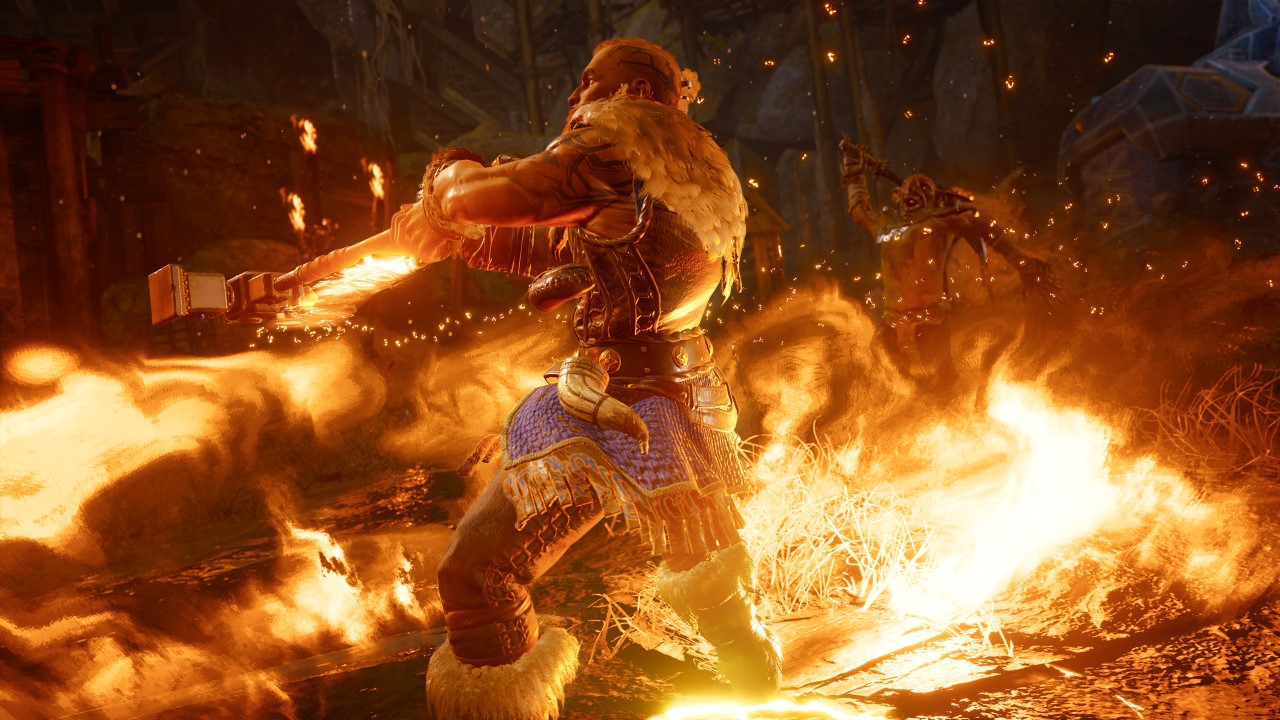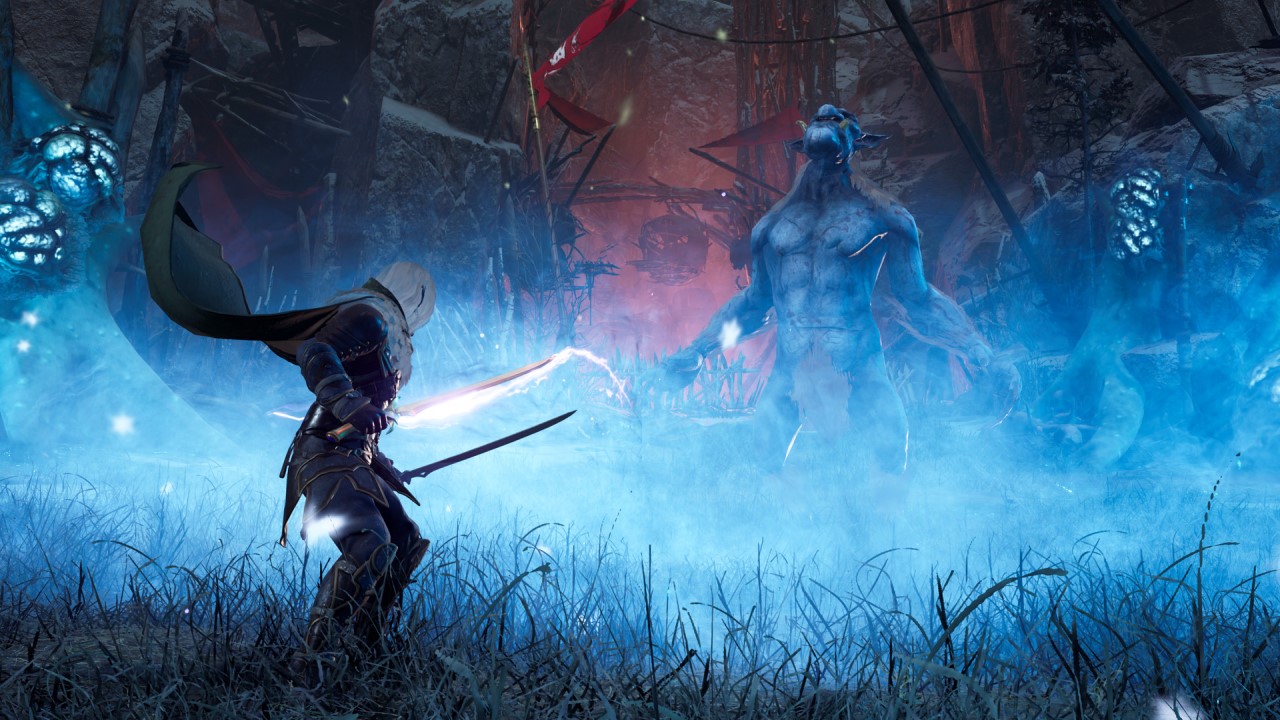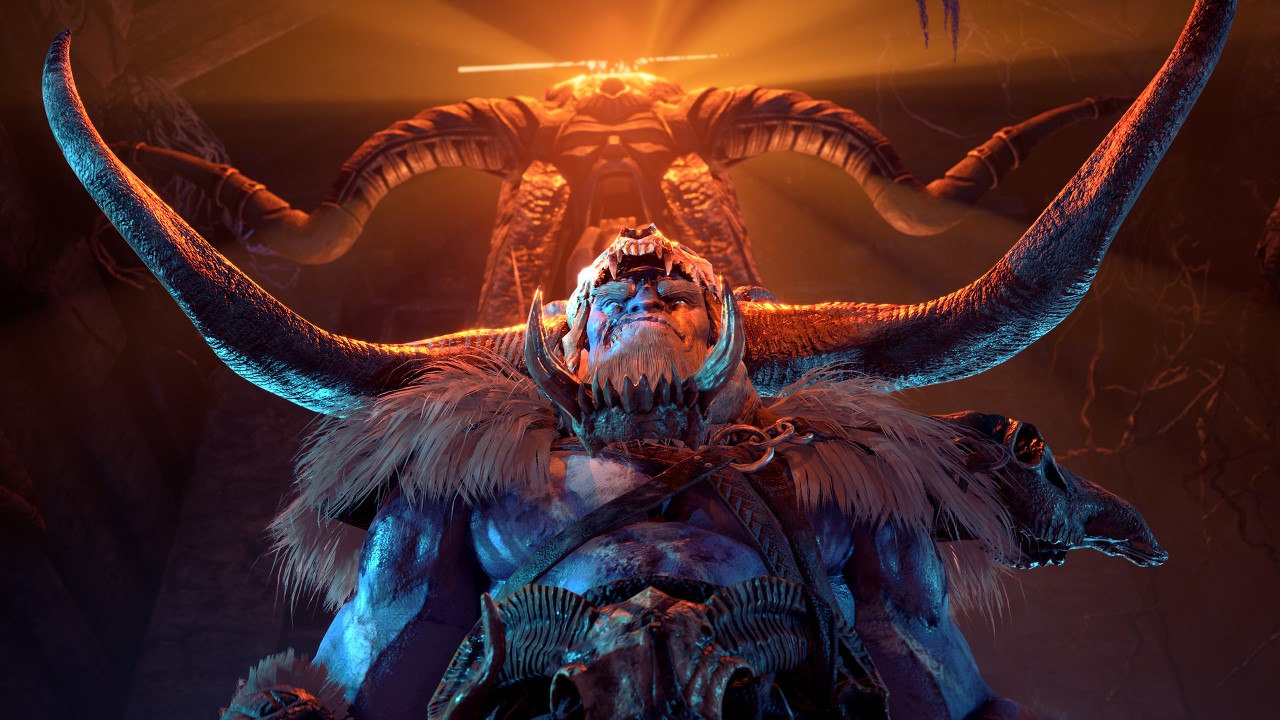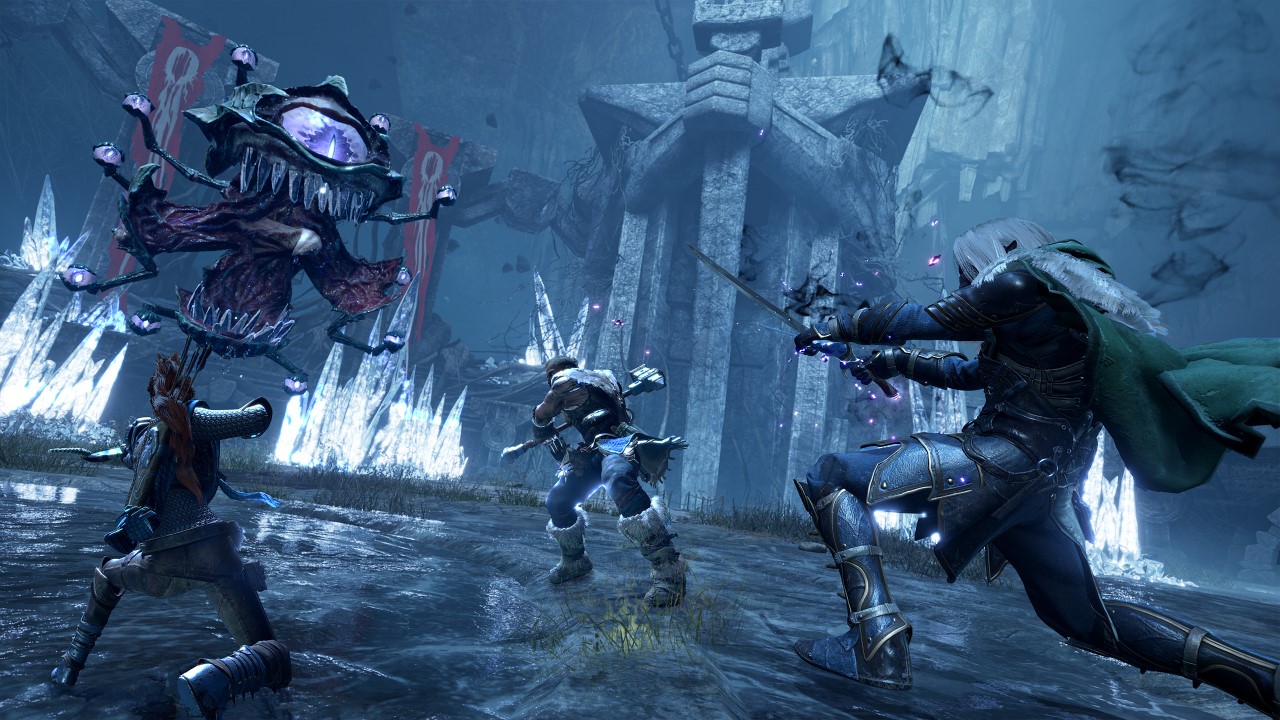Dungeons & Dragons: Dark Alliance has some pretty damn giant sabatons to fill. As the spiritual successor to the beloved Baldur’s Gate: Dark Alliance 1 and 2, and as the first major new D&D game in over 5 years, Tuque Games’ cooperative dungeon crawler has plenty to live up to. Mix in R.A. Salvatore’s iconic Companions of the Hall, and it’s easy to understand why expectations for Dark Alliance are higher than the snow-covered peaks of Icewind Dale. There’s a lot riding on the success of this game, specifically Wizards of the Coasts’ plans to resurrect Dungeons & Dragons as a popular gaming I.P.
It’s then with great joy that I can proclaim Dungeons & Dragons: Dark Alliance largely succeeds in this quest, though not without suffering a few nearly fatal wounds. Thankfully, Dark Alliance passes its saving throw. Like that questionable rogue in your party, Dark Alliance has a few glaring flaws holding it back, yet it’s more than capable of showing you a good time. It just needs to work on a few of its attributes if it plans to survive the next few rounds.
Dungeon & Dragons: Dark Alliance – Emphasis on the “Dungeons.”
For those of you who are still somehow unfamiliar with Dungeons & Dragons, all you need to know about the grandfather of pen and paper roleplaying games is that there are dungeons, and that there are dragons. I’m not trying to be facetious – both feature prominently in Dark Alliance, namely the dungeons. See, Dark Alliance is a dungeon crawler in the most traditional sense: you and preferably a party of friends start from point A in a dark and dangerous location, and make your way to the boss at point B while murdering every single monster along the way.
If you’ve played any recent looter-shooter or live service game in the past few years you’ll pick up on Dark Alliance’s flow rather quickly. While there isn’t an open-world connecting the 21 different dungeons you’ll explore within the Icewind Dale locale of Dungeons & Dragons’ popular Forgotten Realms setting, the hub of Kelvin’ Cairn has everything an adventurer needs before setting out. There’s a map to pick your Quest (Dark Alliance’s name for levels), a merchant to upgrade your armor and other crucial items, and a . . . reward chest?
Dark Alliance has been compared to Fatshark’s Vermintide 2 more than once, and for good reason. Mechanically, the two share very similar progression systems. That reward chest in Kelvin’s Cairn? It’s where you’ll collect your loot post-mission a la the reward coffers in Vermintide 2. The upgrade system for equipment? It’s functionally similar, though you can’t increase an item’s rarity as you can in Vermintide 2. None of the comparisons are 1:1, but the two games are a touch similar at a glance.
By no means is this a bad thing. If imitation is indeed flattery then Dungeons & Dragons: Dark Alliance is shameless in its adoration. But, don’t call Tuque Games’ action-RPG uninspired. In truth, all these comparisons between the two games are only skin deep – Dark Alliance isn’t a mimic of Vermintide 2, but it does remind me of my favorite elements in Fatshark’s title.
One of these elements is the straight-forward dungeon crawling. Unlike Vermintide 2, all 21 dungeons in Dark Alliance are handcrafted. They’re all fairly straight-forward, but with many branching paths and hidden corners to explore. While the graphics are nothing to write a ballad about, the art and level designers absolutely crushed it in Dark Alliance. Each dungeon oozes that distinct D&D aesthetic, though it does go a little heavy on the dwarves early on. From molten dwarven foundries, to dazzling crystal towers, each dungeon is a visual treat.
As for getting in and out of these dungeons there’s very little chaff between you and your dungeon run in Dark Alliance. Simply pick your character, select your quest, then enter the portal to teleport yourself onward to untold adventure! You’ll maim a bunch of monsters, collect loot, defeat a boss, then return home to rinse and repeat until you’re ready for a break. You can do this both solo or in a party of up to four players, though trust me when I say you really, really want to get the band together for this one.

Companions of the Virtual Hall
In Dungeons & Dragons: Dark Alliance you and three friends can take up arms as the famed Companions of the Hall, to include fan-favorite Drizzt Do’Urden. Yes, you can play as Dungeons & Dragons’ most popular Drow fighter, though you’re limited to only one of each character until a post-launch update unlocks the option to play as any combination of Catti-bries, Wulfgars, Bruenors, and Drizzts as your party sees fit.
At the start of the game you’ll be asked to pick one of the four Companions to play as, though you are free to change characters whenever you want (you can even create duplicate characters). Each character has to be leveled up separately (up to a cap of 20), and gear is not shared. Playing as a new character is akin to starting Dark Alliance over again, sans having to unlock the Quests and dungeons once more.
Until Tuque patches in the option to play as any combination of characters, you’ll likely have to play at least two different companions if your gaming group has conflicting picks. This isn’t a huge deal on the surface, but Dark Alliance is very much a cooperative game first and foremost, meaning the solo experience is, well, it’s not the most ideal way to level and gear your characters.
That said, solo is the best way to enjoy the basic narrative and mountains of lore in Dark Alliance. It’s clear Wizards of the Coast hopes to bring new fans into the fold with Dark Alliance, and while the narrative is really just a giant lore-dump, the various tomes and tablets scattered throughout the 21 different dungeons do an excellent job of fleshing out the setting of Icewind Dale and the tale of the Companions of the Hall for newcomers. What better way to collect and enjoy these lore entries than to play uninhibited while alone?
As for gameplay, co-op is the absolute king. Allow me to say this up front: solo play in Dark Alliance is perfectly viable; it’s also not nearly as much fun as dungeon delving with friends. As obvious and eye-rolling as that may sound, the cooperative and solo experiences may as well exist in different realms. You can play Dark Alliance alone and offline, but I don’t recommend it.

It’s Dangerous to Go Alone
It’s important for me to state that I spent the vast majority of my time in Dark Alliance alone. While Tuque did provide us the means to play the game with a full party, my current location is not entirely ideal for online play. Having worked out of the Middle East for a few years now, I’m far more sympathetic to the plight of gamers who either can’t access online games, or are too far from a server to warrant even trying to matchmaker with others.
That’s the situation I found myself in during this review, and I want to commend Tuque for ensuring Dark Alliance was not an always-online experience, with all content available to solo players. That said, the game’s difficulty was clearly balanced around group play, and in many ways this makes the single-player experience one of the most frustrating games I’ve played in recent years. Well, at least until I learned to ignore the recommended Combat Power attached to each difficulty level.
Gear Score, Power Level, Item Level; call it what you will, RPGs these days all seem to feature some numerical indication of your overall strength. In Dungeons & Dragons: Dark Alliance this is represented by your Combat Power. This metric takes your level, allocated Attribute points, and gear into account before shitting out a number that you can then use to determine if you’re ready to take on the next Challenge Level, Dark Alliance’s six difficulty tiers.
There’s just one gnome-sized problem; the recommended Combat Power attached to each Challenge Level was established with cooperative play in mind. To put it bluntly, if you try to tackle a Challenge Level in Dark Alliance at the exact recommended Combat Power while playing solo you’re in for the roughest, toughest, psuedo-Soulslike experience of your gaming life.
You’ll barely dent enemy health and will frequently find yourself dead in a single hit, even from the lowliest of goblins. There’s “git good,” and there’s “git fucked,” and trying to overcome a Challenge Level at the exact recommended Combat Power while playing solo is firmly in the latter camp. It wasn’t until I realized solo was better balanced around playing a full tier lower than the highest available to me that I began to appreciate single-player more.
You’re in for the roughest, toughest, psuedo-Soulslike experience of your gaming life.
Despite this revelation, soloing could still be a pain to enjoy. Enemy aggro is based on proximity in Dark Alliance, so it’s not uncommon to find yourself getting whaled on and pummeled to death even in lower Challenge Levels since your ass is the only one on offer. At higher difficulties, even those you can reasonably handle, this particular A.I. quirk led to many a cheap death, as I’d enter an arena then get routinely massacred by everyone in the room.
Unlike the aforementioned Vermintide 2, you can’t fill your party with A.I. companions in Dark Alliance. While I don’t necessarily want bots that can completely carry my ass, having anyone around to draw aggro while playing alone would have made the overall experience less aggravating. Even one A.I. controlled character would have been nice, if only to have access to the powerful Team Attacks you never get to use while playing solo. At the end of the day, however, it’s you versus the forces of evil in Icewind Dale, and your ass has a bright red bullseye painted on it.
It didn’t help that loot in Dark Alliance is absolutely boring, at least functionally. We live in an odd age of gaming when I have to praise a game for making each new gear drop visually distinct, but here we are and Dark Alliance does indeed get this aspect of loot right. Sure, the textures are a little muddy and not every piece is a beauty, but damn was I happy to have loot that altered my character’s appearance.
The stats, however, are pretty generic for an RPG. There are increases to stamina regeneration, critical hit chance, and total health. You can grab set bonuses that’ll boost the drop chance of health orbs from enemies – you get the point. Mechanically, gear gets the job done, and fans of Dark Alliance will inevitably chase god-rolls that’ll take their builds to the next level. Just, ya know, I kinda expect loot in a hack and slash action-RPG to also change how my character plays, like altering how my attacks work.
Oh well, boring but functional gear is fine at the end of the day, even if it does harm your overall drive to play Dark Alliance solo. The staid loot plus wonky difficulty scaling meant progression felt slow at best, and mind-numbingly tedious at worst whilst playing alone, though to Tuque’s credit they have been absolutely transparent about solo play in Dark Alliance being the inferior way to play. So, hey, I’m overjoyed the option is here and I ultimately enjoyed my time playing the game solo, but if able you should absolutely play Dark Alliance with other people.

(Dodge) Roll for Initiative
Dark Alliance wouldn’t be worth playing in either single-player or multiplayer if the combat was hot garbage. It’s sorta, kinda, maybe the cornerstone of a hack and slash action-RPG, and Dark Alliance’s “Emergent Combat” mostly delivers. It just has Nine Hells of a learning curve.
Dark Alliance utilizes a stamina-based combat system that’s become the norm in the last half-decade. Light attacks and Fierce attacks (heavy attacks by another name) consume stamina, and once you run out you can’t attack, dodge, or block for a moment. On paper, combat isn’t all that different from other, similar action games that map your two attacks to the right trigger and bumper, but it’s the lack of canned animations and more free-form combo system that sets Dark Alliance’s “Emergent Combat” apart from its peers.
Combos can (mostly) be chained together freely, and instead of memorizing complex combo chains players merely need to remember a handful of directional inputs tied to the left stick (or W and S keys on keyboard). In practice this system allows players to chain together attacks easily, yet remains deep enough for hardcore players to master over time. There’s a bit of an issue with the combat that nearly undermines the entire experiment, however.
See, in those other action-RPGs you can tilt the left stick to pivot and shift your attacks in the direction of your choosing. In Dark Alliance your attacks only go in the direction your camera is facing. This wouldn’t be so bad if Dark Alliance drilled that point home, but apparently the game rolled a one in Wisdom because it simply expects players to pick up on this nuance.
You’re supposed to play Dark Alliance like an over-the-shoulder third-person shooter, yet with melee (much like Warframe), but years of established muscle memory run counter to this. You’ll instinctively tilt your left stick to confront an enemy on your flank, but instead of your character turning to face them they’ll launch themselves forward and away from your foe. There isn’t a soft lock-on in Dark Alliance, so if your current target shifts even a little outside the center of your view you’ll whiff your attacks.
It’s the worst implementation of a lock-on system I’ve seen in years.
You could use the hard lock-on feature to focus on a single enemy, except it’s the worst implementation of a lock-on system I’ve seen in years. The camera zooms in so close to your character that you lose all situational awareness of the battlefield. Since enemies attack based on proximity this is a surefire way to get yourself murdered by all the enemies you can no longer see. There is a “threat ring” around your character with arrows that change color to indicate incoming attacks, but it’s impossible to see while locked-on to any given target.
It doesn’t help matters that the camera sensitivity is sluggish on a controller, even when maxed out. Tuque Games claims Dungeons & Dragons is best played with a controller, but the camera-based aiming and slow turn-rate actually make mouse and keyboard the superior input method. For one, most mice can be tuned to compensate for the low camera sensitivity, making it easier and more intuitive to swing your camera round and track enemies in the heat of combat.
Second point of argument: camera-based targeting is more common on PC, so once your camera sensitivity is set just right combat feels much more fluid and responsive with a mouse. As a third and final point: you are always tilting the left stick in some direction, however subtle, on a controller, which leads to combat feeling erratic and uncontrollable after you’ve unlock Moves that rely on it for input. On a keyboard though, players are accustomed to tapping the WASD keys as required, so accidental combo inputs are uncommon.
In short, combat in Dark Alliance can swing in one of two directions depending on your preference of control. With a gamepad you’ll have to unlearn a decade or so of muscle memory, otherwise it’ll feel like the combat is unwieldy and chaotic. With mouse and keyboard you’ll need to remap a couple keybinds, but you’re otherwise in a better position to master Dark Alliance’s “Emergent Combat.”
Combat does come dangerously close to grievously wounding itself in its attempt to be more accessible, but once you realize you need to turn your camera to change the direction of your attacks and that the lock-on is utter trash, it begins to click together, whether you are playing on a controller or with a mouse and keyboard. It may take some time to find its rhythm, but combat in Dark Alliance is a splendid symphony of destruction once it comes together. It just takes a while to get there.
This symphony is all the more enjoyable in co-op, as each player launches a flurry of attacks capable of decimating entire armies of goblins, verbeeg, duergar, and other monstrous members of the titular Dark Alliance. Animations are routinely solid and flow together nicely, and attacks are accompanied by punchy thuds and slashes. It may take some time to acclimate to the controls, but once it gets moving combat in Dark Alliance feels good, and at the end of the day that’s all that really matters.

A Dark Alliance of Issues
That said, Tuque Games should add a soft lock-on of sorts to assist players using a controller, and they need to pull the actual lock-on camera far back. At the least, they need to double the camera sensitivity, because the default is simply far too slow for Dark Alliance’s combat. I foresee many potential fans bouncing off the game due to these small but consequential issues, that’s how impact they are.
These were not the only problems I encountered in Dark Alliance. The game isn’t the buggiest title I’ve played in recent memory, but it’s up there. I’ve drifted away from ladders as I’ve climbed them, and gotten stuck on enemies’ heads. I’ve seen corpses glitch out and jitter within the environment and animations desync, such as the time I knocked a verbeeg onto its fat ass only for it to teleport five meters and back on to its butt after rising to its feet.
The most disruptive bug I noticed was audio not playing in the correct channel. I want to say Dark Alliance has absolutely no positional audio, but it became clear that the entire soundscape was bugged when I noticed audio mixing was all over the place. I’d hear enemies that were in front of me from behind. Music would swell then leap over all other sound channels, drowning out everything else. It’s a shame this bug exists, because the sounds, music, and voice overs in Dark Alliance are all quite good, but it’s difficult to enjoy the soundscape when it’s in such a state of distress.
There are of course faults in the general design as well. Remember that reward chest I mentioned near the top of this review? It’s how you grab your loot after a successful mission, and you have to reveal your loot before moving on, much like a loot box. You can quick equip items from this chest, but you can’t compare the items against your current equipment, defeating the whole purpose of having a quick equip function.
You also cannot mark items as junk, so you have to sell off all your trash one item at a time. Upgrading and downgrading crystals should be an easy to understand process, but it feels like Tuque overthought the whole ordeal. These are just a few of the weird design quirks found throughout Dark Alliance.
Then there are the weird multiplayer issues. You can’t join a party mid-quest, so if someone in your group disconnects they can’t rejoin. If your host disconnects you potentially lose all your loot. If you want to invite someone to your party you need to use your platform’s social menus since there’s no way to do so in-game. For a multiplayer-centric game, Dungeons & Dragons: Dark Alliance does go well out of it’s way to make playing with your friends cumbersome and awkward.
And on and on the list goes. There’s a dark alliance of small yet significant issues hellbent on taking the game down, but they can’t quite pull it off. Dungeons & Dragons: Dark Alliance is very clearly a AA game, though I often wonder what Tuque Games would have done with an extra month of polish. Unlike other games I’ve reviewed this year I feel pretty confident in Tuque’s ability to address these issues; I just hope they’re able to work their magic sooner rather than later.

The Verdict
Dungeons & Dragons: Dark Alliance nearly impales itself on its own sword. Solo play is mediocre at best, the loot is uninspired, and the combat often trips over itself due to a handful of small yet impactful issues. There are a legion of problems harassing the game at every turn, threatening to take it down at any moment. For all intents and purposes Dark Alliance should be an aggressively mediocre video game.
Tuque Games must have rolled a natural 20 on their saving throw, because none of these faults are able to bring Dark Alliance down. It’s a solid cooperative dungeon crawler that’s positively dripping with D&D’s iconic Companions setting and lore. The combat may take some getting used to, and putting your party together is more fiddly than it needs to be, yet Dark Alliance remains an entertaining adventure from beginning to end.











Published: Jun 21, 2021 11:00 am